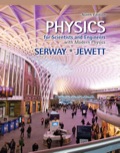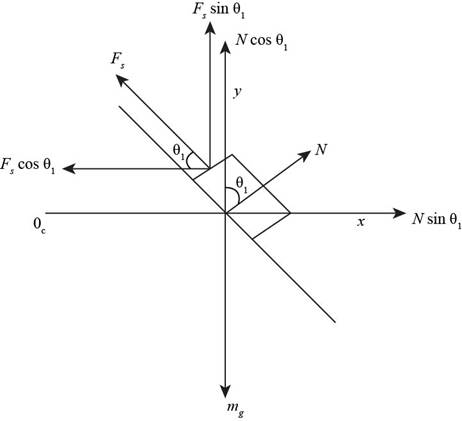
Concept explainers
(a) A luggage carousel at an airport has the form of a section of a large cone, steadily rotating about its vertical axis. Its metallic surface slopes downward toward the outside, making an angle of 20.0° with the horizontal. A piece of luggage having mass 30.0 kg is placed on the carousel at a position 7.46 m measured horizontally from the axis of rotation. The travel bag goes around once in 38.0 s. Calculate the force of staticfriction exerted by the carousel on the bag. (b) The drive motor is shifted to turn the carousel at a higher constant rate of rotation, and the piece of luggage is bumped to another position, 7.94 m from the axis of rotation. Now going around once in every 34.0 s, the bag is on the verge of slipping down the sloped surface. Calculate the coefficient of static friction between the bag and the carousel.
(a)
The force of static friction exerted by the carousel on the bag.
Answer to Problem 6.47AP
The force of static friction exerted by the carousel on the bag is
Explanation of Solution
Given info: The metallic surface of a luggage carousel slopes downward toward outside at an angle
Formula to calculate the centripetal force is,
The horizontal force acting on the bag in horizontal direction is,
Substitute
Here,
Substitute
Draw the free body diagram for the luggage.

From the Figure (1), the component of force in
From the Figure (1), the component of force in
Substitute
Simplify the above equation.
Substitute
Conclusion:
Therefore, the force of static friction exerted by the carousel on the bag is
(b)
The coefficient of friction between the bag and the carousel.
Answer to Problem 6.47AP
The coefficient of friction between the bag and the carousel is
Explanation of Solution
Given info: The metallic surface of a luggage carousel slopes downward toward outside at an angle
Substitute
Calculate the centripetal force for the bag.
Substitute
Calculate the normal force for the bag when it is on the carousel.
Substitute
Formula to calculate the coefficient of friction between the bag and the carousel is,
Substitute
Conclusion:
Therefore, the coefficient of friction between the bag and the carousel is
Want to see more full solutions like this?
Chapter 6 Solutions
EBK PHYSICS FOR SCIENTISTS AND ENGINEER
- The figure (Figure 1) shows representations of six thermodynamic states of the same ideal gas sample. Figure 1 of 1 Part A ■Review | Constants Rank the states on the basis of the pressure of the gas sample at each state. Rank pressure from highest to lowest. To rank items as equivalent, overlap them. ▸ View Available Hint(s) highest 0 ☐ ☐ ☐ ☐ ☐ ☐ Reset Help B F A D E The correct ranking cannot be determined. Submit Previous Answers × Incorrect; Try Again; 4 attempts remaining Provide Feedback lowest Next >arrow_forwardPart A m 2πkT ) 3/2 Calculate the integral (v) = f vƒ (v)dv. The function f(v) describing the actual distribution of molecular speeds is called the Maxwell-Boltzmann distribution, = ƒ(v) = 4π (· v²e-mv²/2kT . (Hint: Make the change of variable v² =x and use the tabulated integral foxne integer and a is a positive constant.) Express your answer in terms of the variables T, m, and appropriate constants. -ax dx n! - an+1 where n is a positive (v) = ΕΠΙ ΑΣΦ Submit Previous Answers Request Answer ? × Incorrect; Try Again; 4 attempts remaining Al Study Tools Looking for some guidance? Let's work through a few related practice questions before you go back to the real thing. This won't impact your score, so stop at anytime and ask for clarification whenever you need it. Ready to give it a try? Startarrow_forwardStarter the rule of significantarrow_forward
- No chatgpt plsarrow_forwardCar A starts from rest at t = 0 and travels along a straight road with a constant acceleration of 6 ft/s^2 until it reaches a speed of 60ft/s. Afterwards it maintains the speed. Also, when t = 0, car B located 6000 ft down the road is traveling towards A at a constant speed of 80 ft/s. Determine the distance traveled by Car A when they pass each other.Write the solution using pen and draw the graph if needed.arrow_forwardIn the given circuit the charge on the plates of 1 μF capacitor, when 100 V battery is connected to the terminals A and B, will be 2 μF A 1 µF B 3 µFarrow_forward
- The velocity of a particle moves along the x-axis and is given by the equation ds/dt = 40 - 3t^2 m/s. Calculate the acceleration at time t=2 s and t=4 s. Calculate also the total displacement at the given interval. Assume at t=0 s=5m.Write the solution using pen and draw the graph if needed.arrow_forwardThe velocity of a particle moves along the x-axis and is given by the equation ds/dt = 40 - 3t^2 m/s. Calculate the acceleration at time t=2 s and t=4 s. Calculate also the total displacement at the given interval. Assume at t=0 s=5m.Write the solution using pen and draw the graph if needed.arrow_forwardThe velocity of a particle moves along the x-axis and is given by the equation ds/dt = 40 - 3t^2 m/s. Calculate the acceleration at time t=2 s and t=4 s. Calculate also the total displacement at the given interval. Assume at t=0 s=5m.Write the solution using pen and draw the graph if needed. NOT AI PLSarrow_forward
 University Physics Volume 1PhysicsISBN:9781938168277Author:William Moebs, Samuel J. Ling, Jeff SannyPublisher:OpenStax - Rice University
University Physics Volume 1PhysicsISBN:9781938168277Author:William Moebs, Samuel J. Ling, Jeff SannyPublisher:OpenStax - Rice University Principles of Physics: A Calculus-Based TextPhysicsISBN:9781133104261Author:Raymond A. Serway, John W. JewettPublisher:Cengage Learning
Principles of Physics: A Calculus-Based TextPhysicsISBN:9781133104261Author:Raymond A. Serway, John W. JewettPublisher:Cengage Learning Physics for Scientists and Engineers: Foundations...PhysicsISBN:9781133939146Author:Katz, Debora M.Publisher:Cengage Learning
Physics for Scientists and Engineers: Foundations...PhysicsISBN:9781133939146Author:Katz, Debora M.Publisher:Cengage Learning Glencoe Physics: Principles and Problems, Student...PhysicsISBN:9780078807213Author:Paul W. ZitzewitzPublisher:Glencoe/McGraw-Hill
Glencoe Physics: Principles and Problems, Student...PhysicsISBN:9780078807213Author:Paul W. ZitzewitzPublisher:Glencoe/McGraw-Hill Classical Dynamics of Particles and SystemsPhysicsISBN:9780534408961Author:Stephen T. Thornton, Jerry B. MarionPublisher:Cengage Learning
Classical Dynamics of Particles and SystemsPhysicsISBN:9780534408961Author:Stephen T. Thornton, Jerry B. MarionPublisher:Cengage Learning Physics for Scientists and Engineers, Technology ...PhysicsISBN:9781305116399Author:Raymond A. Serway, John W. JewettPublisher:Cengage Learning
Physics for Scientists and Engineers, Technology ...PhysicsISBN:9781305116399Author:Raymond A. Serway, John W. JewettPublisher:Cengage Learning





